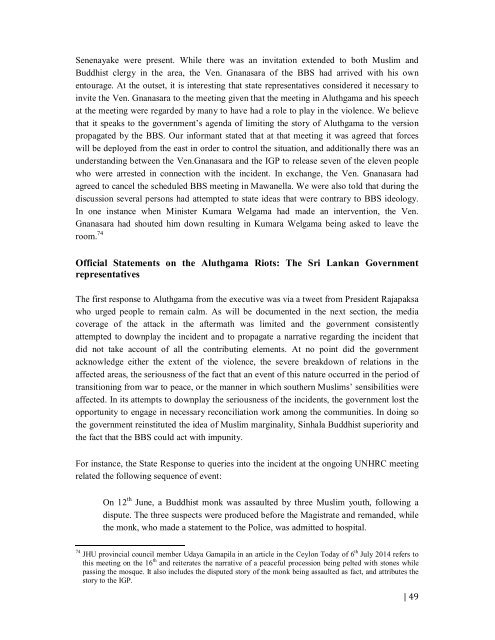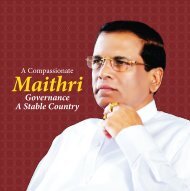You also want an ePaper? Increase the reach of your titles
YUMPU automatically turns print PDFs into web optimized ePapers that Google loves.
Senenayake were present. While there was an invitation extended to both Muslim and<br />
Buddhist clergy in the area, the Ven. Gnanasara of the BBS had arrived with his own<br />
entourage. At the outset, it is interesting that state representatives considered it necessary to<br />
invite the Ven. Gnanasara to the meeting given that the meeting in Aluthgama and his speech<br />
at the meeting were regarded by many to have had a role to play in the violence. We believe<br />
that it speaks to the government’s agenda of limiting the story of Aluthgama to the version<br />
propagated by the BBS. Our informant stated that at that meeting it was agreed that forces<br />
will be deployed from the east in order to control the situation, and additionally there was an<br />
understanding between the Ven.Gnanasara and the IGP to release seven of the eleven people<br />
who were arrested in connection with the incident. In exchange, the Ven. Gnanasara had<br />
agreed to cancel the scheduled BBS meeting in Mawanella. We were also told that during the<br />
discussion several persons had attempted to state ideas that were contrary to BBS ideology.<br />
In one instance when Minister Kumara Welgama had made an intervention, the Ven.<br />
Gnanasara had shouted him down resulting in Kumara Welgama being asked to leave the<br />
room. 74<br />
Official Statements on the Aluthgama Riots: The Sri Lankan Government<br />
representatives<br />
The first response to Aluthgama from the executive was via a tweet from President Rajapaksa<br />
who urged people to remain calm. As will be documented in the next section, the media<br />
coverage of the attack in the aftermath was limited and the government consistently<br />
attempted to downplay the incident and to propagate a narrative regarding the incident that<br />
did not take account of all the contributing elements. At no point did the government<br />
acknowledge either the extent of the violence, the severe breakdown of relations in the<br />
affected areas, the seriousness of the fact that an event of this nature occurred in the period of<br />
transitioning from war to peace, or the manner in which southern Muslims’ sensibilities were<br />
affected. In its attempts to downplay the seriousness of the incidents, the government lost the<br />
opportunity to engage in necessary reconciliation work among the communities. In doing so<br />
the government reinstituted the idea of Muslim marginality, Sinhala Buddhist superiority and<br />
the fact that the BBS could act with impunity.<br />
For instance, the State Response to queries into the incident at the ongoing UNHRC meeting<br />
related the following sequence of event:<br />
On 12 th June, a Buddhist monk was assaulted by three Muslim youth, following a<br />
dispute. The three suspects were produced before the Magistrate and remanded, while<br />
the monk, who made a statement to the Police, was admitted to hospital.<br />
74 JHU provincial council member Udaya Gamapila in an article in the Ceylon Today of 6 th July 2014 refers to<br />
this meeting on the 16 th and reiterates the narrative of a peaceful procession being pelted with stones while<br />
passing the mosque. It also includes the disputed story of the monk being assaulted as fact, and attributes the<br />
story to the IGP.<br />
| 49




